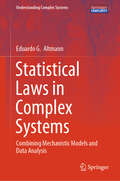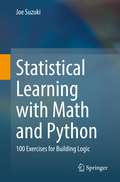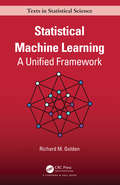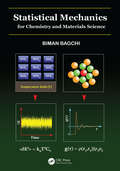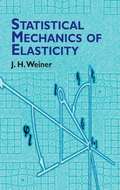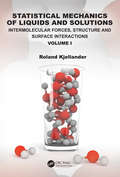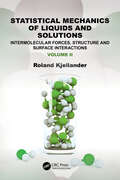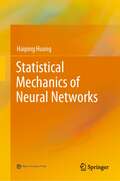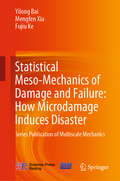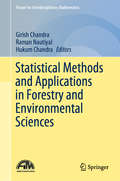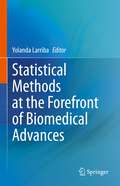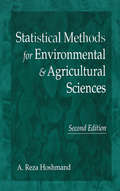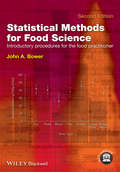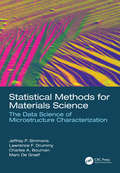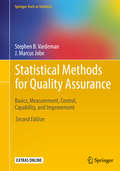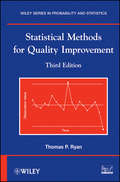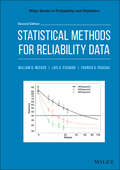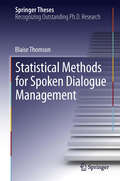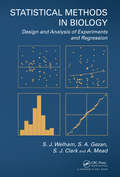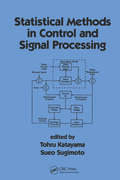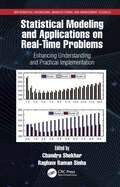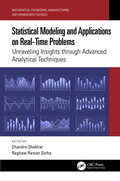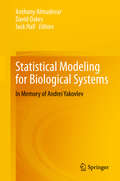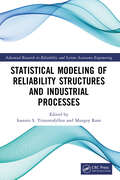- Table View
- List View
Statistical Laws in Complex Systems: Combining Mechanistic Models and Data Analysis (Understanding Complex Systems)
by Eduardo G. AltmannThis book provides a unifying approach to the study of statistical laws, critically evaluating their role in the theoretical understanding of complex systems and the different data-analysis methods used to evaluate them. Statistical laws describe regular patterns observed in diverse scientific domains, ranging from the magnitude of earthquakes (Gutenberg-Richter law) and metabolic rates in organisms (Kleiber's law), to the frequency distribution of words in texts (Zipf's and Herdan-Heaps' laws), and productivity metrics of cities (urban scaling laws). The origins of these laws, their empirical validity, and the insights they provide into underlying systems have been subjects of scientific inquiry for centuries. Through a historical review and a unified analysis, this book argues that the persistent controversies on the validity of statistical laws are predominantly rooted not in novel empirical findings but in the discordance among data-analysis techniques, mechanistic models, and the interpretations of statistical laws. Starting with simple examples and progressing to more advanced time-series and statistical methods, this book and its accompanying repository provide comprehensive material for researchers interested in analyzing data, testing and comparing different laws, and interpreting results in both existing and new datasets.
Statistical Learning with Math and Python: 100 Exercises for Building Logic
by Joe SuzukiThe most crucial ability for machine learning and data science is mathematical logic for grasping their essence rather than knowledge and experience. This textbook approaches the essence of machine learning and data science by considering math problems and building Python programs. As the preliminary part, Chapter 1 provides a concise introduction to linear algebra, which will help novices read further to the following main chapters. Those succeeding chapters present essential topics in statistical learning: linear regression, classification, resampling, information criteria, regularization, nonlinear regression, decision trees, support vector machines, and unsupervised learning. Each chapter mathematically formulates and solves machine learning problems and builds the programs. The body of a chapter is accompanied by proofs and programs in an appendix, with exercises at the end of the chapter. Because the book is carefully organized to provide the solutions to the exercises in each chapter, readers can solve the total of 100 exercises by simply following the contents of each chapter. This textbook is suitable for an undergraduate or graduate course consisting of about 12 lectures. Written in an easy-to-follow and self-contained style, this book will also be perfect material for independent learning.
Statistical Machine Learning: A Unified Framework (Chapman & Hall/CRC Texts in Statistical Science)
by Richard GoldenThe recent rapid growth in the variety and complexity of new machine learning architectures requires the development of improved methods for designing, analyzing, evaluating, and communicating machine learning technologies. Statistical Machine Learning: A Unified Framework provides students, engineers, and scientists with tools from mathematical statistics and nonlinear optimization theory to become experts in the field of machine learning. In particular, the material in this text directly supports the mathematical analysis and design of old, new, and not-yet-invented nonlinear high-dimensional machine learning algorithms. Features: Unified empirical risk minimization framework supports rigorous mathematical analyses of widely used supervised, unsupervised, and reinforcement machine learning algorithms Matrix calculus methods for supporting machine learning analysis and design applications Explicit conditions for ensuring convergence of adaptive, batch, minibatch, MCEM, and MCMC learning algorithms that minimize both unimodal and multimodal objective functions Explicit conditions for characterizing asymptotic properties of M-estimators and model selection criteria such as AIC and BIC in the presence of possible model misspecification This advanced text is suitable for graduate students or highly motivated undergraduate students in statistics, computer science, electrical engineering, and applied mathematics. The text is self-contained and only assumes knowledge of lower-division linear algebra and upper-division probability theory. Students, professional engineers, and multidisciplinary scientists possessing these minimal prerequisites will find this text challenging yet accessible. About the Author: Richard M. Golden (Ph.D., M.S.E.E., B.S.E.E.) is Professor of Cognitive Science and Participating Faculty Member in Electrical Engineering at the University of Texas at Dallas. Dr. Golden has published articles and given talks at scientific conferences on a wide range of topics in the fields of both statistics and machine learning over the past three decades. His long-term research interests include identifying conditions for the convergence of deterministic and stochastic machine learning algorithms and investigating estimation and inference in the presence of possibly misspecified probability models.
Statistical Mechanics for Chemistry and Materials Science
by Biman BagchiThis book covers the broad subject of equilibrium statistical mechanics along with many advanced and modern topics such as nucleation, spinodal decomposition, inherent structures of liquids and liquid crystals. Unlike other books on the market, this comprehensive text not only deals with the primary fundamental ideas of statistical mechanics but also covers contemporary topics in this broad and rapidly developing area of chemistry and materials science.
Statistical Mechanics of Elasticity
by J. H. WeinerAdvanced, self-contained treatment illustrates general principles and elastic behavior of solids. Part 1, based on classical mechanics, studies thermoelastic behavior of crystalline and polymeric solids. Part 2, based on quantum mechanics, focuses on interatomic force laws, behavior of solids, and thermally activated processes. 96 figures. 1983 edition.
Statistical Mechanics of Liquids and Solutions: Intermolecular Forces, Structure and Surface Interactions
by Roland KjellanderThe statistical mechanical theory of liquids and solutions is a fundamental area of physical sciences with important implications for many industrial applications. This book shows how you can start from basic laws for the interactions and motions of microscopic particles and calculate how macroscopic systems of these particles behave, thereby explaining properties of matter at the scale that we perceive. Using this microscopic, molecular approach, the text emphasizes clarity of physical explanations for phenomena and mechanisms relevant to fluids, addressing the structure and behavior of liquids and solutions under various conditions. A notable feature is the author’s treatment of forces between particles that include nanoparticles, macroparticles, and surfaces. The book also provides an expanded, in-depth treatment of polar liquids and electrolytes.
Statistical Mechanics of Liquids and Solutions: Intermolecular Forces, Structure and Surface Interactions
by Roland KjellanderThe statistical mechanical theory of liquids and solutions is a fundamental area of physical sciences with important implications in other fields of science and industrial applications. Statistical Mechanics of Liquids and Solutions: Intermolecular Forces, Structure and Surface Interactions is the second in a series of two on this subject. While the first volume introduced equilibrium statistical mechanics in general and statistical mechanics of liquids and solutions at an introductory level, the present volume presents an advanced treatment of the subject and penetrates much deeper into liquid state theory.A major theme in both books is the intimate relationship between forces in a fluid and the fluid structure - a relationship that is paramount for the understanding of the subject of interactions in dense fluids. Using this microscopic, molecular approach, the text emphasizes clarity of physical explanations for phenomena and mechanisms relevant to fluids, addressing the structure and behavior of liquids and solutions under various conditions. A notable feature is the author's treatment of intermolecular interactions in liquids and solutions that include interactions between nanoparticles, macroparticles, and surfaces. The book provides an in-depth treatment of simple liquids, molecular fluids, particle dispersions, dense ionic fluids and electrolyte solutions with molecular solvent, both in the bulk and in confinement. It contains a unified exact treatment of electrolyte solutions, ionic liquids and polar fluids as well as approximate theories and applications.Statistical Mechanics of Liquids and Solutions will be an invaluable resource for graduate and postgraduate students in physics, chemistry, soft matter science, surface and colloid science and related fields, as well as professionals and instructors in those areas of science.
Statistical Mechanics of Neural Networks
by Haiping HuangThis book highlights a comprehensive introduction to the fundamental statistical mechanics underneath the inner workings of neural networks. The book discusses in details important concepts and techniques including the cavity method, the mean-field theory, replica techniques, the Nishimori condition, variational methods, the dynamical mean-field theory, unsupervised learning, associative memory models, perceptron models, the chaos theory of recurrent neural networks, and eigen-spectrums of neural networks, walking new learners through the theories and must-have skillsets to understand and use neural networks. The book focuses on quantitative frameworks of neural network models where the underlying mechanisms can be precisely isolated by physics of mathematical beauty and theoretical predictions. It is a good reference for students, researchers, and practitioners in the area of neural networks.
Statistical Mechanics of Superconductivity
by Takafumi KitaThis book provides a theoretical, step-by-step comprehensive explanation of superconductivity for undergraduate and graduate students who have completed elementary courses on thermodynamics and quantum mechanics. To this end, it adopts the unique approach of starting with the statistical mechanics of quantum ideal gases and successively adding and clarifying elements and techniques indispensible for understanding it. They include the spin-statistics theorem, second quantization, density matrices, the Bloch-De Dominicis theorem, the variational principle in statistical mechanics, attractive interaction and bound states. Ample examples of their usage are also provided in terms of topics from advanced statistical mechanics such as two-particle correlations of quantum ideal gases, derivation of the Hartree-Fock equations, and Landau's Fermi-liquid theory, among others. With these preliminaries, the fundamental mean-field equations of superconductivity are derived with maximum mathematical clarity based on a coherent state in terms of the Cooper-pair creation operator, a quasiparticle field for describing the excitation and the variational principle in statistical mechanics. They have the advantage that the phase coherence due to the Cooper-pair condensation can be clearly seen making the superfluidity comprehensible naturally. Subsequently, they are applied to homogeneous cases to describe the BCS theory for classic s-wave superconductors and its extension to the p-wave superfluidity of 3He. Later, the mean-field equations are simplified to the Eilenberger and Ginzburg-Landau equations so as to describe inhomogeneous superconductivity such as Abrikosov's flux-line lattice concisely and transparently. Chapters provide the latest studies on the quasiclassical theory of superconductivity and a discovery of p-wave superfluidity in liquid 3He. The book serves as a standard reference for advanced courses of statistical mechanics with exercises along with detailed answers.
Statistical Meso-Mechanics of Damage and Failure: Series Publication of Multiscale Mechanics
by Yilong Bai Mengfen Xia Fujiu KeThis book introduces a trans-scale framework necessary for the physical understanding of breakdown behaviors and presents some new paradigm to clarify the mechanisms underlying the trans-scale processes. The book, which is based on the interaction of mechanics and statistical physics, will help to deepen the understanding of how microdamage induces disaster and benefit the forecasting of the occurrence of catastrophic rupture. It offers notes and problems in each part as interesting background and illustrative exercises.Readers of the book would be graduate students, researchers, engineers working on civil, mechanical and geo-engineering, etc. However, people with various background but interested in disaster reduction and forecasting, like applied physics, geophysics, seismology, etc., may also be interested in the book.
Statistical Methods and Applications in Forestry and Environmental Sciences (Forum for Interdisciplinary Mathematics)
by Girish Chandra Raman Nautiyal Hukum ChandraThis book presents recent developments in statistical methodologies with particular relevance to applications in forestry and environmental sciences. It discusses important methodologies like ranked set sampling, adaptive cluster sampling, small area estimation, calibration approach-based estimators, design of experiments, multivariate techniques, Internet of Things, and ridge regression methods. It also covers the history of the implementation of statistical techniques in Indian forestry and the National Forest Inventory of India.The book is a valuable resource for applied statisticians, students, researchers, and practitioners in the forestry and environment sector. It includes real-world examples and case studies to help readers apply the techniques discussed. It also motivates academicians and researchers to use new technologies in the areas of forestry and environmental sciences with the help of software like R, MATLAB, Statistica, and Mathematica.
Statistical Methods at the Forefront of Biomedical Advances
by Yolanda LarribaThis book presents novel statistics methods and reproducible software that helps to solve challenging problems in biomedicine. Specifically, it consists of a collection of 11 chapters contributed by some of the leading experts in the mathematical and statistical field which address new challenges in very disparate biomedical areas, such as genomics, cancer, circadian biology, microbiome, mental disorders, and more. The mathematical rigor is written in a user-friendly way to serve a general biomedical audience ranging from trainees or students to doctors, as well as scientific researchers, university departments, and PhD students.
Statistical Methods for Environmental and Agricultural Sciences
by Reza HoshmandThe first edition of this book, popular around the world, is surpassed only by this new Second Edition. Improvements such as new and revised exercises, a broad range of practical and relevant case studies, and expanded theoretical concepts make this even better for users of statistics. The book emphasizes the practical application of statistics and provides examples in various fields of environmental and agriculture sciences. Because it uses simple, non-mathematical language to present statistical techniques, the reader requires only a familiarity with elementary algebra and mathematical notations to understand and apply the concepts described. This logically organized book covers the following topics: Part 1 introduces statistical concepts as they apply to different fields of environmental and agriculture sciences and provides descriptive measures of central tendency and variability; Part 2 covers probability and sampling concepts used in inferential statistics; Part 3 presents parametric methods in hypothesis testing, which include research designs; Part 4 discusses a number of nonparametric techniques; Part 5 explains tests of association and prediction; and lastly, analysis of change over time is detailed in Part 6. The appendices contain statistical tables for reference purposes.
Statistical Methods for Food Science: Introductory Procedures for the Food Practitioner
by John A. BowerThe recording and analysis of food data are becoming increasingly sophisticated. Consequently, the food scientist in industry or at study faces the task of using and understanding statistical methods. Statistics is often viewed as a difficult subject and is often avoided because of its complexity and a lack of specific application to the requirements of food science. This situation is changing – there is now much material on multivariate applications for the more advanced reader, but a case exists for a univariate approach aimed at the non-statistician. This second edition of Statistical Methods for Food Science provides a source text on accessible statistical procedures for the food scientist, and is aimed at professionals and students in food laboratories where analytical, instrumental and sensory data are gathered and require some form of summary and analysis before interpretation. It is suitable for the food analyst, the sensory scientist and the product developer, and others who work in food-related disciplines involving consumer survey investigations will also find many sections of use. There is an emphasis on a ‘hands-on’ approach, and worked examples using computer software packages and the minimum of mathematical formulae are included. The book is based on the experience and practice of a scientist engaged for many years in research and teaching of analytical and sensory food science at undergraduate and post-graduate level. This revised and updated second edition is accompanied by a new companion website giving the reader access to the datasets and Excel spreadsheets featured in the book. Check it out now by visiting www.wiley.com/go/bower/statistical or by scanning the QR code below.
Statistical Methods for Materials Science: The Data Science of Microstructure Characterization
by Marc De Graef Jeffrey P. Simmons Lawrence F. Drummy Charles A. BoumanData analytics has become an integral part of materials science. This book provides the practical tools and fundamentals needed for researchers in materials science to understand how to analyze large datasets using statistical methods, especially inverse methods applied to microstructure characterization. It contains valuable guidance on essential topics such as denoising and data modeling. Additionally, the analysis and applications section addresses compressed sensing methods, stochastic models, extreme estimation, and approaches to pattern detection.
Statistical Methods for Quality Assurance
by Stephen B. Vardeman J. Marcus JobeThe Tools You Need To Be A Successful Engineer As you read through this new text, you'll discover the importance of Statistical Quality Control (SQC) tools in engineering process monitoring and improvement. You'll learn what SQC methods can and cannot do, and why these are valuable additions to your engineering tool kit. And instead of overwhelming you with unnecessary details, the authors make the implementation of statistical tools "user-friendly. " The rich set of examples and problems integrated throughout this book will help you gain a better understanding of where and how to apply SQC tools. Real projects, cases and data sets show you clearly how SQC tools are used in practice. Topics are covered in the right amount of detail to give you insight into their relative importance in modern quality assurance and the ability to immediately use them. This approach provides the mix of tools you'll need to succeed in your engineering career. Key Features of the Text * Provides a coherent presentation of the role of statistics in quality assurance. * Places special attention on making sure that while the technical details are absolutely correct, they do not overwhelm the reader. * Presents the material in realistic contexts, with examples and problems that are based on real-world projects, cases and data sets. * The implementation of statistical tools is user-friendly. * The statistical treatment emphasizes graphics and estimation (and de-emphasizes hypothesis testing).
Statistical Methods for Quality Improvement
by Thomas P. RyanPraise for the Second Edition "As a comprehensive statistics reference book for quality improvement, it certainly is one of the best books available. " -Technometrics This new edition continues to provide the most current, proven statistical methods for quality control and quality improvement The use of quantitative methods offers numerous benefits in the fields of industry and business, both through identifying existing trouble spots and alerting management and technical personnel to potential problems. Statistical Methods for Quality Improvement, Third Edition guides readers through a broad range of tools and techniques that make it possible to quickly identify and resolve both current and potential trouble spots within almost any manufacturing or nonmanufacturing process. The book provides detailed coverage of the application of control charts, while also exploring critical topics such as regression, design of experiments, and Taguchi methods. In this new edition, the author continues to explain how to combine the many statistical methods explored in the book in order to optimize quality control and improvement. The book has been thoroughly revised and updated to reflect the latest research and practices in statistical methods and quality control, and new features include: Updated coverage of control charts, with newly added tools The latest research on the monitoring of linear profiles and other types of profiles Sections on generalized likelihood ratio charts and the effects of parameter estimation on the properties of CUSUM and EWMA procedures New discussions on design of experiments that include conditional effects and fraction of design space plots New material on Lean Six Sigma and Six Sigma programs and training Incorporating the latest software applications, the author has added coverage on how to use Minitab software to obtain probability limits for attribute charts. new exercises have been added throughout the book, allowing readers to put the latest statistical methods into practice. Updated references are also provided, shedding light on the current literature and providing resources for further study of the topic. Statistical Methods for Quality Improvement, Third Edition is an excellent book for courses on quality control and design of experiments at the upper-undergraduate and graduate levels. the book also serves as a valuable reference for practicing statisticians, engineers, and physical scientists interested in statistical quality improvement.
Statistical Methods for Reliability Data (Wiley Series in Probability and Statistics)
by William Q. Meeker Luis A. Escobar Francis G. PascualAn authoritative guide to the most recent advances in statistical methods for quantifying reliability Statistical Methods for Reliability Data, Second Edition (SMRD2) is an essential guide to the most widely used and recently developed statistical methods for reliability data analysis and reliability test planning. Written by three experts in the area, SMRD2 updates and extends the long- established statistical techniques and shows how to apply powerful graphical, numerical, and simulation-based methods to a range of applications in reliability. SMRD2 is a comprehensive resource that describes maximum likelihood and Bayesian methods for solving practical problems that arise in product reliability and similar areas of application. SMRD2 illustrates methods with numerous applications and all the data sets are available on the book’s website. Also, SMRD2 contains an extensive collection of exercises that will enhance its use as a course textbook. The SMRD2's website contains valuable resources, including R packages, Stan model codes, presentation slides, technical notes, information about commercial software for reliability data analysis, and csv files for the 93 data sets used in the book's examples and exercises. The importance of statistical methods in the area of engineering reliability continues to grow and SMRD2 offers an updated guide for, exploring, modeling, and drawing conclusions from reliability data. SMRD2 features: Contains a wealth of information on modern methods and techniques for reliability data analysis Offers discussions on the practical problem-solving power of various Bayesian inference methods Provides examples of Bayesian data analysis performed using the R interface to the Stan system based on Stan models that are available on the book's website Includes helpful technical-problem and data-analysis exercise sets at the end of every chapter Presents illustrative computer graphics that highlight data, results of analyses, and technical concepts Written for engineers and statisticians in industry and academia, Statistical Methods for Reliability Data, Second Edition offers an authoritative guide to this important topic.
Statistical Methods for Spoken Dialogue Management
by Blaise ThomsonSpeech is the most natural mode of communication and yet attempts to build systems which support robust habitable conversations between a human and a machine have so far had only limited success. A key reason is that current systems treat speech input as equivalent to a keyboard or mouse, and behaviour is controlled by predefined scripts that try to anticipate what the user will say and act accordingly. But speech recognisers make many errors and humans are not predictable; the result is systems which are difficult to design and fragile in use. Statistical methods for spoken dialogue management takes a radically different view. It treats dialogue as the problem of inferring a user's intentions based on what is said. The dialogue is modelled as a probabilistic network and the input speech acts are observations that provide evidence for performing Bayesian inference. The result is a system which is much more robust to speech recognition errors and for which a dialogue strategy can be learned automatically using reinforcement learning. The thesis describes both the architecture, the algorithms needed for fast real-time inference over very large networks, model parameter estimation and policy optimisation. This ground-breaking work will be of interest both to practitioners in spoken dialogue systems and to cognitive scientists interested in models of human behaviour.
Statistical Methods in Biology: Design and Analysis of Experiments and Regression
by A. Mead S.J. Welham S.A. Gezan S.J. ClarkWritten in simple language with relevant examples, this illustrative introductory book presents best practices in experimental design and simple data analysis. Taking a practical and intuitive approach, it only uses mathematical formulae to formalize the methods where necessary and appropriate. The text features extended discussions of examples that include real data sets arising from research. The authors analyze data in detail to illustrate the use of basic formulae for simple examples while using the GenStat statistical package for more complex examples. Each chapter offers instructions on how to obtain the example analyses in GenStat and R.
Statistical Methods in Control & Signal Processing (Electrical and Computer Engineering)
by Tohru Katayama Sueo SugimotoPresenting statistical and stochastic methods for the analysis and design of technological systems in engineering and applied areas, this work documents developments in statistical modelling, identification, estimation and signal processing. The book covers such topics as subspace methods, stochastic realization, state space modelling, and identification and parameter estimation.
Statistical Modeling and Applications on Real-Time Problems: Enhancing Understanding and Practical Implementation (ISSN)
by Chandra Shekhar Raghaw Raman SinhaIn the dynamic landscape of modern data analysis, this curated guide by global experts explores the latest in statistical methodologies, modeling techniques, and optimization strategies. This comprehensive text offers insights into diverse fields such as engineering, economics, medicine, and agriculture, addressing real-world challenges. It delves into the intricacies of the Lomax distribution under a Type II censoring scheme, exploring various loss functions. The compilation uncovers estimators for population proportion, product of two population means, and more, supported by empirical and simulation studies. Additionally, it scrutinizes the prevalence of caesarean section deliveries in India, correlating with socio-economic factors.This book· Traverses diverse fields for insights into real-world challenges.· Delves into the intricacies of the Lomax distribution under a Type II censoring scheme.· Uncovers estimators supported by empirical and simulation studies.· Scrutinizes the prevalence of caesarean section deliveries in India, correlating with socio-economic factors.This compilation promises a holistic exploration of advanced statistical and optimization methods, offering readers valuable insights into their pragmatic applications across a spectrum of real-world issues.
Statistical Modeling and Applications on Real-Time Problems: Unraveling Insights through Advanced Analytical Techniques (ISSN)
by Chandra Shekhar Raghaw Raman SinhaIn an era dominated by mathematical and statistical models, this book unravels the profound significance of these tools in decoding uncertainties within numerical, observational, and calculation-based data. From governmental institutions to private entities, statistical prediction models provide a critical framework for optimal decision-making, offering nuanced insights into diverse realms, from climate to production and beyond.This book·Serves as a comprehensive resource in statistical modeling, methodologies, and optimization techniques across various domains.·Features contributions from global authors; the compilation comprises 10 insightful chapters, each addressing critical aspects of estimation and optimization through statistical modeling.·Covers a spectrum of topics, from non-parametric goodness-of-fit statistics to Bayesian applications; the book explores novel resampling methods, advanced measures for empirical mode, and transient behavior analysis in queueing systems.·Includes asymptotic properties of goodness-of-fit statistics, practical applications of Bayesian Statistics, modifications to the Hard EM algorithm, and explicit transient probabilities.·Culminates with an exploration of an inventory model for perishable items, integrating preservation technology and learning effects to determine the economic order quantity.This book stands as a testament to global collaboration, offering a rich tapestry of commendable statistical and mathematical modeling alongside real-world problem-solving. It is poised to ignite further exploration, discussion, and innovation in the realms of statistical modeling and optimization.
Statistical Modeling for Biological Systems: In Memory of Andrei Yakovlev
by David Oakes Anthony Almudevar Jack HallThis book commemorates the scientific contributions of distinguished statistician, Andrei Yakovlev. It reflects upon Dr. Yakovlev’s many research interests including stochastic modeling and the analysis of micro-array data, and throughout the book it emphasizes applications of the theory in biology, medicine and public health. The contributions to this volume are divided into two parts. Part A consists of original research articles, which can be roughly grouped into four thematic areas: (i) branching processes, especially as models for cell kinetics, (ii) multiple testing issues as they arise in the analysis of biologic data, (iii) applications of mathematical models and of new inferential techniques in epidemiology, and (iv) contributions to statistical methodology, with an emphasis on the modeling and analysis of survival time data. Part B consists of methodological research reported as a short communication, ending with some personal reflections on research fields associated with Andrei and on his approach to science. The Appendix contains an abbreviated vitae and a list of Andrei’s publications, complete as far as we know. The contributions in this book are written by Dr. Yakovlev’s collaborators and notable statisticians including former presidents of the Institute of Mathematical Statistics and of the Statistics Section of the AAAS. Dr. Yakovlev’s research appeared in four books and almost 200 scientific papers, in mathematics, statistics, biomathematics and biology journals. Ultimately this book offers a tribute to Dr. Yakovlev’s work and recognizes the legacy of his contributions in the biostatistics community.
Statistical Modeling of Reliability Structures and Industrial Processes (ISSN)
by Mangey Ram Ioannis S. TriantafyllouThis reference text introduces advanced topics in the field of reliability engineering, introduces statistical modeling techniques, and probabilistic methods for diverse applications.It comprehensively covers important topics including consecutive-type reliability systems, coherent structures, multi-scale statistical modeling, the performance of reliability structures, big data analytics, prognostics, and health management. It covers real-life applications including optimization of telecommunication networks, complex infrared detecting systems, oil pipeline systems, and vacuum systems in accelerators or spacecraft relay stations. The text will serve as an ideal reference book for graduate students and academic researchers in the fields of industrial engineering, manufacturing science, mathematics, and statistics.
